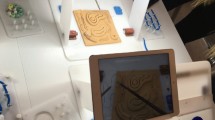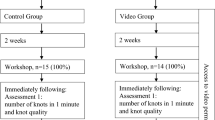Abstract
Purpose
There are two groups of undergraduate students involved in endoscopic surgery with different degrees of experience: average and more experience. This study proves whether the subjective impression of the laparoscopic trainer is verifiable and which factors influence extreme talent.
Methods
21 medical students of the eighth term of the University of Witten-Herdecke participated in the study. On their first course day, students got instructed in suturing and knot technique. They were then required to tie a maximum of five knots within 2 h. After a week, students repeated this procedure. Time used for tying knots was stopped.
Results
Regarding the time students used for their first knots, great differences were provable (7–8 min, average 23 min). However, an adaption of the knotting time was noticed at the end of the first course day. This was confirmed during the second course day. Neither acquired factors (music, sport, etc.) nor individual factors (visual acuity, handedness, etc.) had any impact on the time used for knotting. Merely, one advantage was seen with the first knots with the factors of playing the guitar and having a more than 10-h surgical previous experience. Knotting times leveled off at 95% to less than 10 min, though.
Discussion
Neither normally talented nor extremely talented junior surgeons could be noticed, and so could not the co-factors providing an advantage or disadvantage for surgery, respectively. All prospective surgeons can learn defined tasks (knots) by short interval training, and thus show similarly good results after a few repetitions.

Similar content being viewed by others
References
Gerabek WE, Haage BD, Keil G, Wegner W (2005) Enzyklopädie Medizingeschichte. Kapitel Laparoskopie, 19th edn. De Gruyter, Berlin
Alkatout I, Mettler L (2018) Hysterectomy. A comprehensive surgical approach. Kapitel 16: learning by doing: how to teach hysterectomy, 1st edn. Springer, Heidelberg, pp 235–248
Gallagher A, Satava R (2002) Virtual reality as a metric for the assessment of laparoscopic psychomotor skills: learning curves and reliability measures. Surg Endosc 16:1746–1752
www.faa.gov/regulations_policies/handbooks_manuals/aviation/risk_management_handbook/media/rmh_ch02.pdf. Accessed June 2018
Gallagher AG, Lederman AB, Mc Glade K, Satava RM, Smith CD (2004) Discriminative validity of the minimally invasive surgical trainer in virtual reality (MIST-VR) using criteria levels based on expert performance. Surg Endosc 18(4):660–665
Gallagher AG, Ritter EM, Champion H et al (2005) Virtual reality simulation for the operating room: proficiency-based training as a paradigm shift in surgical skill training. Ann Surg 241(2):364–372
Fu S, Liu X, Zhou L, Zhou M, Wang L (2017) Applied research on laparoscopic simulator in the resident surgical laparoscopic operation technical training. Indian J Surg 79(4):288–293
Lencioni RD, Ragle CA, Kinser ML, Coffey T, Fransson BA (2017) Effect of simulator orientation during skills training on performance of basic laparoscopic tasks by veterinary students. J Am Vet Med Assoc 251(10):1196–1201
Cole SJ, Mackenzie H, Ha J, Hanna GB, Miskovic D (2014) Randomized controlled trial on the effect of coaching in simulated laparoscopic training. Surg Endosc 28(3):979–986
Spruit EN, Band GPH, van der Heijden KB, Hamming JF (2017) The effects of spacing, naps and fatigue on the acquisition and retention of laparoscopic skills. J Surg Endosc 74(3):530–538
Spencer F (1978) Teaching and measuring surgical techniques: the technical evaluation of competence. Bull Am Coll Surg 63:9–12
Spüntrup C, Noé GK, Spüntrup E (2012) Lernprogramme in der Gynäkologie: learning by doing – aber bitte erst am Modell. Der Frauenarzt 53(10):952–957
Munro MG (2012) Surgical simulation: where have we come from? Where are we now? Where are we going? J Minim Invasive Gynecol 19(3):272–283
Author information
Authors and Affiliations
Contributions
SF, JCR-preparation of the manuscript, data analysis, literature review, ES-statistics, PS-layout, AH-language editing, EFS-counseling, proof of content, MB-figure, CS-tables, data collection, study design.
Corresponding author
Ethics declarations
Conflict of interest
The authors declare that they have no conflict of interest.
Ethical approval
The study was conducted in concordance to the ethical standards of the institution.
Informed consent
All 21 candidates signed an informed consent due to ethical standards before initiation of the study.
Additional information
Publisher's Note
Springer Nature remains neutral with regard to jurisdictional claims in published maps and institutional affiliations.
Rights and permissions
About this article
Cite this article
Findeklee, S., Spüntrup, E., Radosa, J.C. et al. Endoscopic surgery: talent or training?. Arch Gynecol Obstet 299, 1331–1335 (2019). https://doi.org/10.1007/s00404-019-05116-w
Received:
Accepted:
Published:
Issue Date:
DOI: https://doi.org/10.1007/s00404-019-05116-w




